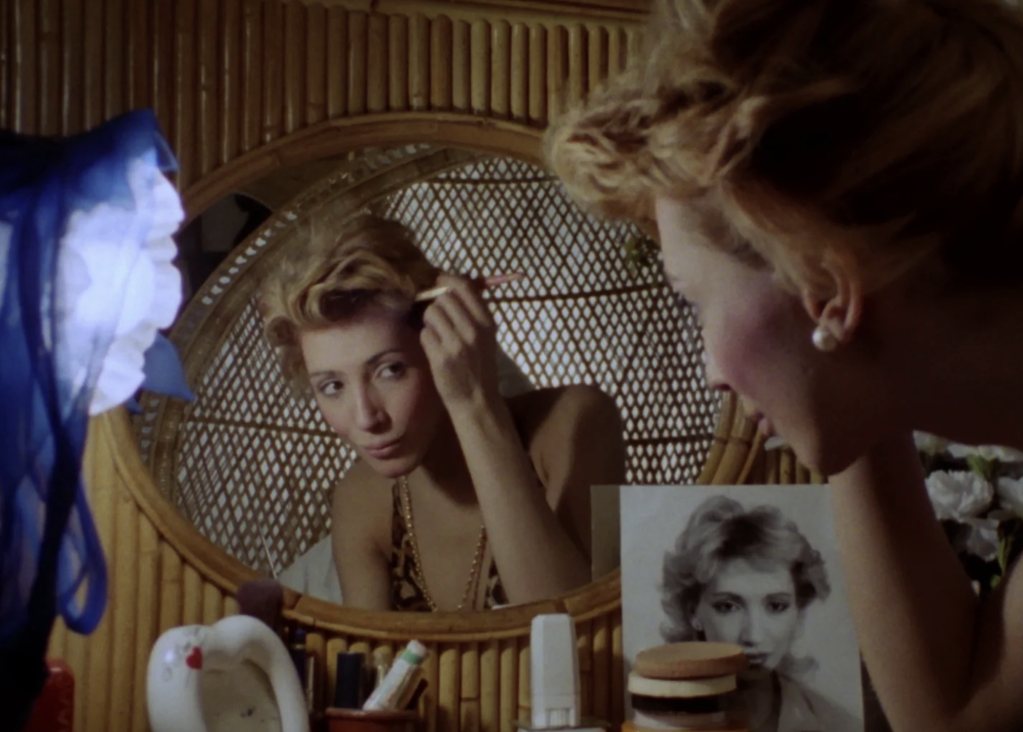Surrounded by the Palacio de Cristal del Retiro’s luminous glass walls, six transgender women, all of them sex workers, congregate for drinks and discussion, some of it confiding and funny but more of it playfully catty. Their relationships with one another unclear outside of their shared line of work, the women have been called together by director Antonio Giménez-Rico for a documentary in which they will, in addition to shooting the shit with each other in this glamorously windowed hall, tell us about their lives. Their stories are cut away to like mini-travelogues or, at their most intimate, visual diary entries.
Toiling in obscurity for several years before it was restored and theatrically released a few years ago, Dressed in Blue (1983) is an essential document of transgender life in Spain less than a decade after the death of dictator Francisco Franco. With a handful of reenactments and regularly staged action — one scene might see, for instance, the camera perched on a john’s passenger seat, and another might show a hot-and-heavy moment between one of the women and her boyfriend — the film is more akin to a lightly fictionalized reality show than journalism but is no less powerful a piece of work because of it.
If they were featured at all in the media at the time, transgender people were generally characterized as exotic curiosities at best and objects of shame at worst. Dressed in Blue, in contrast, is only ever empathetic, immovably letting the women speak for themselves. It doesn’t butt in to editorialize or armchair-diagnose — suggest that it knows these people better than they know themselves. Its spirit is unmistakably one of respect, borne of an intent by Giménez-Rico to humanize a demographic routinely treated as lesser. (The film’s approach became even clearer to Giménez-Rico once he started seriously pursuing the project: he originally wanted to make a movie about transgender women who held so-called “important” roles in society, but once he started researching he found prospective subjects almost exclusively discriminated into sex work, art, and hairdressing, often all at once to make ends meet.)

From Dressed in Blue.
Giménez-Rico gaze doesn’t court sensationalism; it isn’t excessively focused on the sex work the way a lesser director might. Multidimensional Dressed in Blue is sturdily matter-of-fact, depicting its subjects as they see themselves. It doesn’t gloss over the cruelties they’re often subjected to, but it’s careful about not giving those cruelties the final word — about not undermining the resilience of the women who absorb it. The movie is keen on showing as much as possible, even sitting in on a breast-implant surgery one of the subjects gets shortly after we’ve met her. (That’s arguably the closest the film gets to something like acquiescing to lurid interest.)
The women are linked by their unwavering confidence and their shared milieu, but Giménez-Rico makes it a point to cast a wide net, with some subjects greener in their identities and others veterans. Some have baggage they’re trying to keep to the past — one used to be married to a woman, with whom she tensely reunites toward the end of the film — and others are able to live more freely, like one young woman whose family is universally accepting and who says she’s happy funding her relatively successful traveling nightclub act with the sex work (which she enjoys) she practices on the side.
You fall in something like love watching Dressed in Blue; it’s devastating knowing that four of its subjects would be gone in only a few years, their lives taken prematurely by AIDS. The film is historically significant for its compassionate portrayal of trans people, but hindsight adds poignance, knowing that the majority of these abbreviated biographies would not get much more time to evolve — to see transiently mentioned dreams come to life. Dressed in Blue allows us to honor who these women were.
